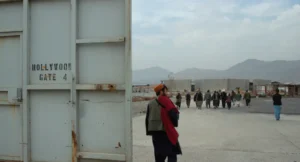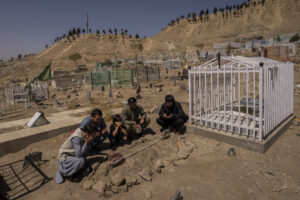No Good Reasons to Continue America’s Longest War
Our costly presence in Afghanistan is on track to continue at least another decade, as politicians fail to articulate past failures or envision future strategy. An Afghan woman in Kabul reads about President Trump's decision to recommit the United States to the 16-year-old war. (Rahmat Gul / AP)
An Afghan woman in Kabul reads about President Trump's decision to recommit the United States to the 16-year-old war. (Rahmat Gul / AP)
The longest war in modern U.S. history approaches its 16th anniversary Saturday, and so far there is no end in sight. The war in Afghanistan began in the aftermath of the Sept. 11, 2001, terrorist attacks in New York City and Washington, D.C., with the promise of vengeance aimed at the Taliban, hosts of al-Qaida and Osama bin Laden. But that original justification—still as morally questionable now as it was then—has gotten lost amid the open-ended rhetoric of “fighting terrorism.”
The Pentagon recently disclosed that the actual number of U.S. troops currently in Afghanistan is 11,000—significantly higher than previously acknowledged. The announcement came just days after President Donald Trump announced an open-ended escalation of the war. With 4,000 more troops now heading to Afghanistan, Sen. Bob Corker, R-Tenn., who heads the Senate Foreign Relations Committee, confirmed in an interview that U.S. troops will remain in Afghanistan for at least another decade. It is a pity that neither Trump nor Corker has been asked to justify the presence of troops in the country for another decade when the first 16 years of the war appear to have yielded little of value. Indeed, few American politicians who have supported and extended the war year after year are able to articulate past failures or envision any future strategy that holds promise. And so the war continues, seemingly because we have no idea how or why to end it.
When questioned about the war strategy by the House and Senate Armed Services Committees, Trump administration officials were hard-pressed to respond, saying only that the Afghan military was more likely to win against the Taliban with U.S. troops advising and supporting it. But the past 16 years of U.S. military involvement have been variations on the same theme: training, supporting and advising Afghan forces while dropping bombs and conducting raids in parallel. If that strategy hasn’t worked for 16 years, why would it work now?
Afghan civilians are caught between corrupt, U.S.-backed warlords in government, U.S. troops on the ground and airstrikes from above, Taliban forces, and now an emerging Islamic State presence. The war has hardly improved their lives and will likely mean many more years of violence. The Revolutionary Association of the Women of Afghanistan, the oldest women’s political organization in the country, warned 16 years ago against U.S. intervention. A member of RAWA (who uses the pseudonym Heela to protect her identity) told me in a recent interview that Trump’s plan is “not really a new strategy for Afghanistan or for the Afghan people. Nor was it a surprise.” She explains that his plan “is actually a very small tactical change in the wider strategy that the U.S. has in the entire region and especially in Afghanistan.”
That broader plan, which Heela sees as unchanged despite the addition or withdrawal of a few thousands troops by various presidents every few years, is continuing the U.S. use of Afghanistan’s “geographic location to keep its rivals like Russia, India, China, Iran, under its thumb.” She adds, “That strategy is not going to change under Trump or any other president for many years to come.”
If reducing terrorism was its goal, the U.S. has spectacularly failed in Afghanistan and appears to not care one way or another. Aside from the terror it has rained down on Afghans year after year, U.S. presence there has only resulted in the Taliban gaining strength, the U.S.-backed government becoming more corrupt and the emergence of new formations based on fundamentalist ideologies. But if, as Heela suggests, the goal is to maintain a strategic presence in Central Asia, near the territories of political rivals, the war is ostensibly achieving that goal—albeit at a heavy human and financial cost.
Already this year, well before Trump announced his position on the war in Afghanistan, U.S. violence in the country was on the rise. The Bureau of Investigative Journalism has tracked American airstrikes there since 2015 and has found a near-exponential rise in bombings. In 2015, the organization recorded 236 airstrikes; in 2016 the number increased to 1,071, and a whopping 2,353 airstrikes were recorded in just the first nine months of this year. The latter number includes the “mother of all bombs”—the U.S.’s largest non-nuclear weapon—which was used in April. Not surprisingly, civilian deaths are proportionately higher, with the United Nations reporting a 43 percent increase in casualties from airstrikes by both the U.S. and Afghan forces.
Heela adds that another aspect of the war in Afghanistan—one that has placed a huge burden on civilians but rarely gets media coverage—is the U.S.-backed government. “The jihadist government of Afghanistan is still in power, and is enjoying the full support of the U.S.,” she says. Recently, for example, “Gulbuddin Hekmatyar—one of the most infamous, bloodthirsty, criminal warlords of the past three decades—was welcomed back to the government by the U.S.,” Heela notes. The Guardian confirms her assessment:
Among Afghanistan’s many warlords, Hekmatyar stands out with an almost unparalleled record of human rights abuses. Aside from indiscriminate shelling of civilians, he is accused of assassinating intellectuals, feminists and royalists. His followers have run torture chambers in Pakistan and thrown acid at women.
If there is any clear pattern to U.S. policy in Afghanistan dating from the Cold War to today, it is the backing of fundamentalist warlords and criminals who are ideologically similar to the Taliban and al-Qaida. A recent exposé by Afghanistan-based journalist May Jeong for In These Times magazine recounts how U.S.-backed militias have fought battles “off the books” and with little oversight, so that even the Pentagon has no real records of the extent of their crimes. Under this informal system, there is no accountability, no prosecutions for war crimes, no responsibility and no justice.
The financial cost of America’s endless war in Afghanistan also is a massive burden to taxpayers. The troop increase this year will cost more than $1 billion annually, bringing the total cost of the war to $12.5 billion a year. As the U.S. government pours such huge amounts of money into a war that has played no constructive role in the lives of ordinary Americans (or Afghans), members of Congress this week “struggle[d] to find money for the popular Children’s Health Insurance Program.”
Most importantly, ordinary Afghans, sick of American interference and destruction, want us gone. “Today the [Afghan] people more than ever, especially people in isolated provinces, where they experience drone strikes and airstrikes, night raids or patrols, definitely hate the U.S. more than [they hate] the Taliban and want them to leave,” Heela explains, adding that Afghan citizens “see the [Afghan] government as the lackeys of the occupiers.”
A 16-year-old in the United States today may wonder why U.S. troops are fighting in the longest modern war, as there is no apparent value to a cause that has resulted in death, destruction and wasted resources. Unless something changes, another 10 years will pass with Americans remaining blind to the reasons for the war and Afghans continuing to pay the price of our ignorance.
Your support is crucial...As we navigate an uncertain 2025, with a new administration questioning press freedoms, the risks are clear: our ability to report freely is under threat.
Your tax-deductible donation enables us to dig deeper, delivering fearless investigative reporting and analysis that exposes the reality beneath the headlines — without compromise.
Now is the time to take action. Stand with our courageous journalists. Donate today to protect a free press, uphold democracy and uncover the stories that need to be told.






You need to be a supporter to comment.
There are currently no responses to this article.
Be the first to respond.